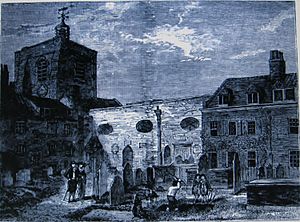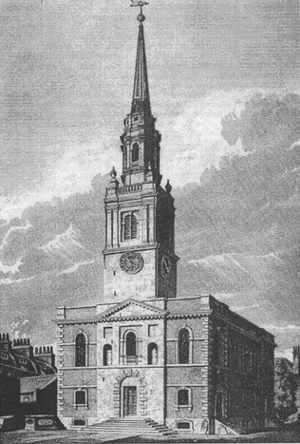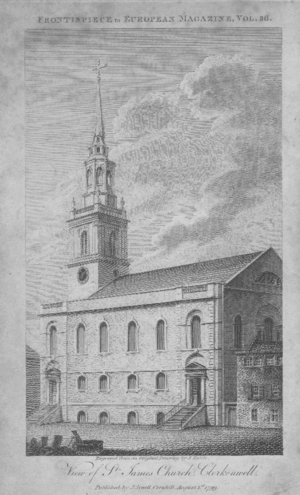St James's Church, Clerkenwell facts for kids
St James Church, Clerkenwell is an Anglican church located in Clerkenwell, a part of London, England. It has a long and interesting history, dating back many centuries.
Contents
Church History
Old Nunnery: About 1100 to 1539
The area of Clerkenwell is known for its natural springs, which gave the place its name. Long ago, in the time of King Henry II, London's parish clerks would perform special plays based on Bible stories here. Sometimes, even kings and queens would come to watch!
Around the year 1100, a nobleman named Jordan Briset started a nunnery (a place where nuns live) dedicated to St Mary. This nunnery became very rich and important. It even had a special pilgrimage spot at Muswell Hill, and the church kept land there for a long time.
The First St James Church: 1540 to 1788
When King Henry VIII closed down the nunneries, the church building was taken over by the local people. They had already been using part of it for a while. The land where the nunnery stood was given to Thomas Howard, 3rd Duke of Norfolk, in 1540. However, the church building itself changed hands many times until 1656. At that point, it was given to trustees who looked after it for the local people. These people also gained the right to choose their own vicar (the church leader). This was quite unusual, and they kept this right even after the king returned to power in 1660.
Choosing a vicar was a big event, much like a public election, and it happened all the way into the early 1900s! This led to the church having a very simple and traditional style of worship.
In 1596, the famous writer George Peele was buried in this church.
In 1623, the church's tall steeple fell down twice, but it was successfully rebuilt. An interesting fact: Pocahontas and John Rolfe's son, Thomas Rolfe, got married here in September 1632. He married Elizabeth Washington, and they had a daughter named Anne a year later. Sadly, Elizabeth died soon after Anne was born. Thomas returned to Jamestown, Virginia, two years later, leaving his daughter with his cousin.
It is also thought that the playwrights Thomas Dekker (in 1632) and Thomas Heywood (in 1641) were buried at the church.
In 1737, Matthew King, who was a partner of the famous highwayman Dick Turpin, was buried here at age 25. He was reportedly shot by Turpin during a robbery.
The New St James Church: 1792 to Today
Quick facts for kids Clerkenwell Church Act 1788 |
|
|---|---|
| Act of Parliament | |

|
|
| Long title | An Act for pulling down the Church of Saint James at Clerkenwell in the County of Middlesex, and for building a new Church; and making a new Church Yard or Cemetery in the said Parish, with convenient Avenues and Passages thereto. |
| Citation | 28 Geo. 3. c. 10 |
| Dates | |
| Royal assent | 20 March 1788 |
By 1788, the old church was a mix of different styles and was starting to fall apart. So, in that year, a special law was passed by Parliament to rebuild the church. The money for this was raised by selling special bonds. The new church was designed by a local architect named James Carr. He created a building that was great for preaching, with beautiful details inspired by famous architects like Christopher Wren and James Gibbs. The new church was officially opened in 1792.
Later, in 1822, upper balconies were added for the children of the Sunday School, which had started in 1807 and is still active today. The back parts of these balconies were for poorer people. The church tower was repaired in 1849, and the whole church was restored again in 1882 by Sir Arthur Blomfield. Inside, there's a cool curved wall at the back that helps with the sound. The stained glass windows at the front were made in 1863.
The church's organ was built in 1792. It still has many of its original pipes and a beautiful wooden case. It was rebuilt in 1978 to bring it back to its original style. The tower also has a set of eight bells, which were made in 1791 and recast in 1928.
A picture of the church was even featured on the front page of The European Magazine in 1799!
The church's basement, called the crypt, was once used for burials. But in the early 1900s, many coffins were moved, and the crypt was turned into a large hall. This new hall was opened in 1912 by Princess Marie Louise of Schleswig-Holstein. It was later updated and reopened in 1994 and again in 1999, when a special area for young people was created.
Over the 20th century, some nearby church areas that had once been part of St James's were reunited with it. One of these was the parish of St Peter, which had a church built to remember the Smithfield Martyrs (people who died for their beliefs). That church was badly damaged in a war and later taken down, but St James's now has a memorial to these martyrs.
From 1998 to 2018, the Rev Andrew Baughen was the vicar of St James.
Special Features of the Church
The church today still has many interesting things from its past:
- The communion table and rail (where people take communion) are original. They are curved and made of mahogany wood, decorated with feathers and a dove, which represents the Holy Spirit.
- A wooden statue of St James, which used to be over a poor box in the old church, is now above the main entrance inside the church.
- There are several old monuments from the first church. These were saved and put up in the new church and its porch.
- Inside the church, you can find:
- A wall plaque for William Wood, a famous archer who died in 1691.
- A large wall plaque for Elizabeth, Countess Dowager of Exeter, which talks about her important family and her daughters' marriages.
- A brass plaque from the 1500s for John Bell, Bishop of Worcester, who lived in Clerkenwell and was buried in the old church in 1556.
- In the church porch, you can see memorials to:
- Gilbert Burnet, Bishop of Salisbury, a well-known writer and preacher who died in 1714.
- Henry Penton, who died in 1714. His grandson later developed the area now called Pentonville.
- Thomas Crosse and his wife, from 1712, which is a sculpture by Roubiliac.
- Inside the church, you can find:
- The porch also has "benefaction boards." These are lists of charities that still help elderly people in Clerkenwell today, some dating back to the time of Queen Elizabeth I.
- Above the main entrance inside the church are the royal arms of George III, made in 1792.
- The church has a memorial for the victims of the "Fenian Conspiracy," which was an explosion near the nearby Clerkenwell Prison that killed 12 people and injured 120.
- There is also a modern memorial inside the church to 66 martyrs from 1400 to 1558, who died in the Smithfield Fires. This memorial is in a blocked-up doorway called the "Martyrs Door."
St James Today
In 2018, Rev. Mark Jackson and Rev. Pete Nicholas became the new leaders of St James Clerkenwell. They combined the church with an initiative called ‘Inspire London’ to form Inspire Saint James Clerkenwell. Rev. Mark Jackson became the main vicar in December 2022.
The Crypt
The crypt, which is the large space under the church, was made usable in 1912. It has a main room, a side room, and a kitchen. The main room has a cool vaulted brick ceiling and wooden floors. It's used by the church and the local community.
Because it's so beautiful and located in the heart of London, the crypt is a popular place for art shows, filming, parties, meetings, and wedding receptions. It has been used as a filming location for TV shows like Songs of Praise, music videos, and movies such as About A Boy, Holmes & Watson, and Black Earth Rising.





